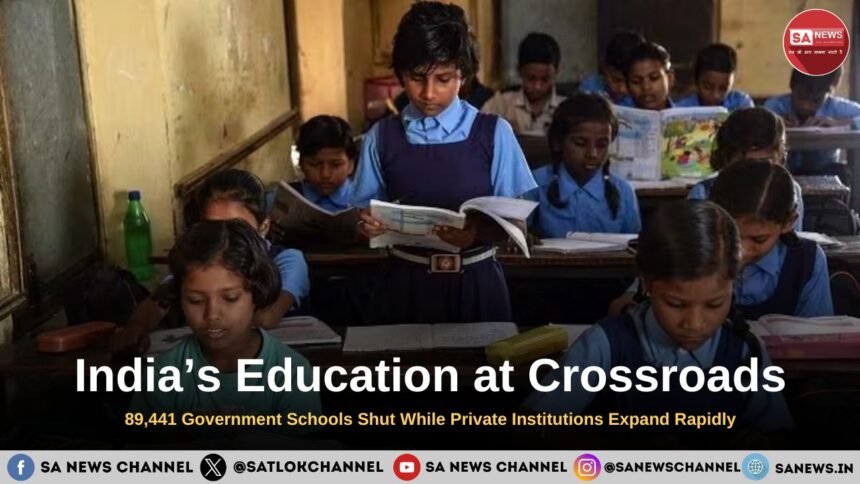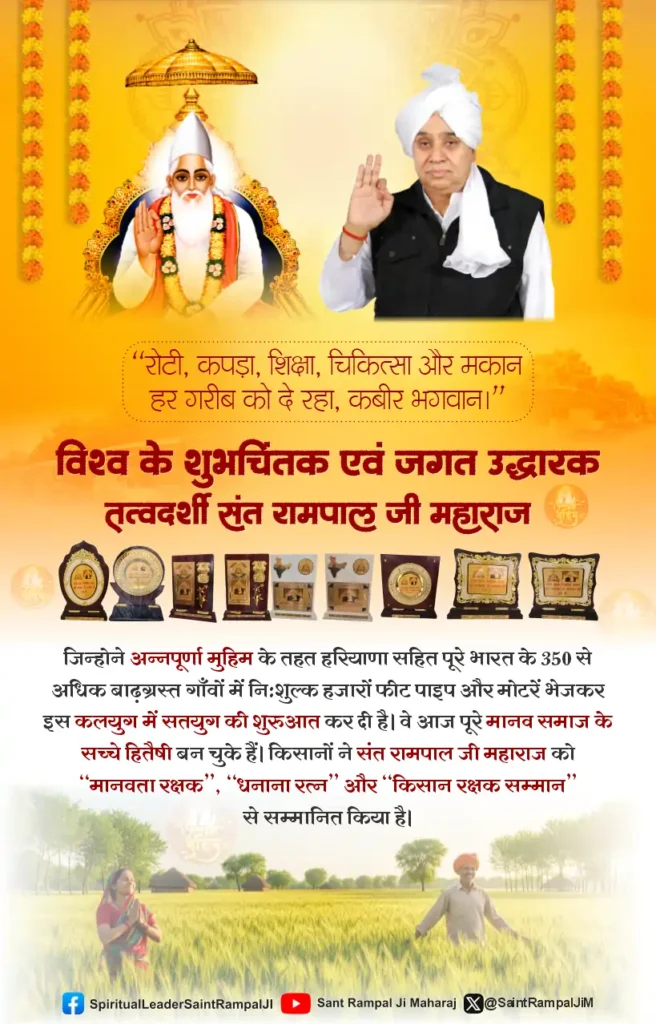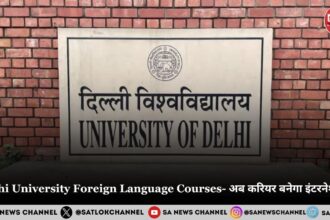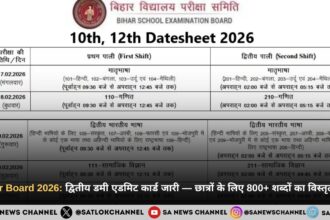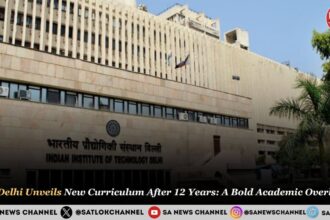India, once celebrated for expanding access to primary education post-independence, is now witnessing a major crisis. According to official records, 89,441 government schools have been shut down in the last ten years, while private schools have expanded across states. Critics argue that this shift undermines the constitutional Right to Education, especially for poor families who cannot afford rising private school fees.
- Children of Leaders Abroad, Children of the Poor at Risk
- School Closures in Numbers
- NITI Aayog’s Policy and State Action
- Government vs Private: The Expanding Gap
- Declining Enrolment in Government Schools
- Why Are Families Choosing Private Schools?
- The Financial Burden on the Poor
- Privatization and Its Wider Impact
- The Shrinking Right to Education
- A Nation at Risk of Losing Its Educational Gains
- Education and the Eternal Knowledge of Saint Rampal Ji Maharaj Ji
- FAQs on Closure of Government Schools and Education Privatization in India
Children of Leaders Abroad, Children of the Poor at Risk
While the children of top political leaders are enrolled in prestigious global universities London School of Economics, Harvard, Yale, Georgetown, and the University of Pennsylvania millions of poor Indian children are struggling to access even basic schooling. The closure of government schools raises critical questions: Is education slowly becoming a privilege rather than a right?
School Closures in Numbers
Over the past decade, 89,441 government schools were shut, of which nearly 65,000 (73%) were in BJP-ruled states.
State & Schools Closed/Merged
- Madhya Pradesh ➡️ 29,410
- Rajasthan ➡️ 17,129 merged, 4,000 shut
- Uttar Pradesh ➡️ 26,000 closed (with 27,000 more proposed)
- Telangana ➡️ 2,000
- Odisha ➡️ 5,000
- Uttarakhand ➡️ 1,200
This large-scale closure has drastically reduced access for children in rural and semi-urban regions.
NITI Aayog’s Policy and State Action
The Planning Commission, which once focused on development-based strategies, was replaced by NITI Aayog in 2015. In 2023, NITI Aayog officially recommended the merger of schools. However, several states had already begun closures soon after 2014, particularly those with “double engine” BJP governments.
Government vs Private: The Expanding Gap
- While government schools decline, private schools are multiplying.
- 42,944 private schools were opened in the same period when 89,441 government schools shut down.
- The annual closure rate of government schools stands at 8%, while private schools are growing at nearly double the pace (15%).
This clearly shows a planned push towards privatization of education.
Declining Enrolment in Government Schools
Data from the Unified District Information System for Education Plus (UDISE+) highlights a worrying trend:
- In 2022–23, enrolment in Uttar Pradesh’s government primary schools was 1.92 crore students.
- By 2023–24, this number fell to 1.74 crore.
- In the current year, enrolment dropped further to 1.52 crore, a loss of 22 lakh students in just one year.
- Across India, 5,303 aided government schools were lost between 2023–24 and 2024–25.
Why Are Families Choosing Private Schools?
Parents often prefer private schools for several reasons:
- Poor infrastructure in government schools (lack of toilets, unsafe buildings).
- Severe shortage of teachers 9,508 schools in UP function with only one teacher, handling around 6.2 lakh students.
- Lack of English-medium instruction, despite demand among parents.
- Teachers engaged in non-teaching duties like mid-day meals, census, and polio campaigns.
The Financial Burden on the Poor
India has 80 crore people dependent on ration subsidies, yet private school fees continue to rise beyond affordability. Many families who turned to government schools during COVID-19 due to job losses now face school shutdowns. This raises fears that millions of children will simply drop out, increasing illiteracy in the coming decades.
Privatization and Its Wider Impact
The closure of schools is not an isolated event. Critics compare it to earlier trends where public institutions like BSNL, HAL, and State Roadways were weakened to benefit private players. Today, education appears to be moving down the same path. Reports also suggest that some closed schools in Uttar Pradesh may be handed over to private or RSS-backed institutions, deepening the privatization debate.
The Shrinking Right to Education
India’s literacy rate rose from 18% at independence to 74% by the 2011 Census, largely due to expansion of government primary schools. However, if closures continue at this scale, experts warn the literacy rate may stagnate or decline. More worryingly, the Right to Education Act, a constitutional guarantee, risks becoming hollow for millions of poor and rural children.
A Nation at Risk of Losing Its Educational Gains
The closure of 89,441 schools in 10 years, rising private dominance, and falling enrolment numbers signal an alarming trend. If not reversed, the gap between rich and poor in education will widen sharply. While elite families send their children abroad, the poor risk being denied even the most basic schooling.
Education was once considered the backbone of India’s democracy and social justice. Weakening it could weaken the very foundation of the nation.
Education and the Eternal Knowledge of Saint Rampal Ji Maharaj Ji
Supreme God Kabir Himself has chosen this era for His children. Long before, He had already decided that at this age, every child would get an education. But the true purpose of education is not only reading and writing ; it is to recognize the Supreme God. As Tatvdarshi Saint Rampal Ji Maharaj Ji explains through His unique spiritual knowledge, real education means knowing the Creator, understanding the path to attain Him, and reaching the eternal abode Satlok.
In this world, even the most educated people still suffer from sorrow, disease, and uncertainty. The final aim of knowledge is to go beyond temporary worldly success and to achieve everlasting happiness. That is possible only when the children of God recognize their true Father and follow His path.
For more about the divine knowledge of Saint Rampal Ji Maharaj Ji, visit: www.jagatgururampalji.org
FAQs on Closure of Government Schools and Education Privatization in India
Q1. Why are so many government schools being closed in India?
According to reports and
commentary, large numbers of schools have been shut or merged as part of policy directions linked with NITI Aayog’s recommendations. The government argues low student enrollment and poor infrastructure make many schools unviable, while critics see it as a move toward education privatization.
Q2. How many schools have been closed in the last decade?
The content highlights that in the past 10 years, around 89,441 government schools have been shut down across the country, with about 65,000 of them (73%) in states governed by the BJP.
Q3. Which states have seen the highest number of school closures?
Madhya Pradesh (29,410 schools), Rajasthan (17,129 merged + 4,000 shut), Telangana (2,000), Odisha (5,000), and Uttarakhand (1,200) are among the states mentioned as having witnessed large-scale closures.
Q4. What is happening to private schools during this period?
While government schools are closing, private schools are rapidly increasing. For example, where nearly 89,000 government schools shut down, about 42,944 new private schools opened. UDISE Plus data (2024–25) shows private schools rising from 3.31 lakh to 3.39 lakh in a single year.
Q5. How does this impact students from poor families?
The closure of free/low-cost government schools forces poor students toward expensive private schools, which most families (80 crore people depending on ration, as per text) cannot afford. This raises concerns of rising illiteracy, reduced access to education, and weakening of constitutional rights like the Right to Education.


